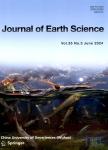Sulfur and Oxygen Isotopes of Sulfate Extracted from Early Cambrian Phosphorite Nodules: Implications for Marine Redox Evolution in the Yangtze Platform
Sulfur and Oxygen Isotopes of Sulfate Extracted from Early Cambrian Phosphorite Nodules: Implications for Marine Redox Evolution in the Yangtze Platform作者机构:Guizhou Geological Survey Guiyang Guizhou Province 550018 China Key Laboratory of Orogenic Belts and Crustal Evolution MOE & School of Earth and Space Sciences Peking University Beijing 100871 China Department of Geology and Geophysics Louisiana State University Baton Rouge LA 70803 USA
出 版 物:《Journal of Earth Science》 (地球科学学刊(英文版))
年 卷 期:2016年第27卷第2期
页 面:170-179页
核心收录:
学科分类:070902[理学-地球化学] 070903[理学-古生物学与地层学(含:古人类学)] 0709[理学-地质学] 07[理学] 0708[理学-地球物理学] 0704[理学-天文学]
基 金:supported by the Natural Science Foundation of China (Nos. 41272017, 41322021) Chinese Geological Survey Program (No. 1212011120622)
主 题:phosphorite nodules Niutitang Formation phosphorite associated sulfate sulfurisotope oxygen isotope.
摘 要:Phosphorite nodule beds are discovered in the black shale of basal Niutitang Formation throughout the Yangtze Platform in South China, recording an important phosphorite-generation event. Platform-wide phosphorite precipitation requires special oceanographic and geochemical conditions, thus the origin of the Niutitang phosphorite nodules may provide valuable information about the ocean chemistry in the Early Cambrian. In this study, we measured sulfur and oxygen isotopic compositions of sulfate extracted from phosphorite nodules collected from the basal Niutitang Formation. Phosphorite associated sulfate(PAS) is a trace amount of sulfate that incorporates into crystal lattice during phosphorite precipitation, accordingly PAS records the geochemical signals during phosphorite nodule formation. Sulfur isotopic composition of PAS(δ^(34)S_(PAS)) ranges from-1.16‰ to +24.48‰(mean=+8.19‰, n=11), and oxygen isotopic value(δ^(18)O_(PAS)) varies between-5.3‰ and +26.3‰(mean=+7.0‰, n=8). Most phosphorite nodules have low δ^(34)SPAS and low δ^(18)O_(PAS) values, suggesting PAS mainly derived from anaerobic oxidation of H_2S within suboxic sediment porewater. We propose that phosphate was delivered to the Yangtze Platform by a series of upwelling events, and was scavenged from seawater with the precipitation of FeOOH. The absorbed phosphate was released into suboxic porewater by the reduction of FeOOH at the oxic-suboxic redox boundary in sediments, and phosphorite nodule precipitated by the reaction of phosphate with Ca^(2+) diffused from the overlying seawater. The platform-wide deposition of phosphorite nodules in the basal Niutitang Formation implies the bottom water might be suboxic or even oxic, at least sporadically, in Early Cambrian. We speculate that the intensified ocean circulation as evident with frequent occurrences of upwelling events might be the primary reason for the episodic oxidation of the Yangtze Platform in Early Cambrian.



